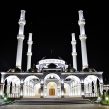
North Caucasus Builds More and Bigger Mosques
Publication: Eurasia Daily Monitor Volume: 12 Issue: 95
By:

After the demise of the Soviet state with its atheist policies, a massive process of rebuilding old and building new mosques started across the North Caucasus. Today, Chechnya has nearly 1,000 mosques and Dagestan has two or three times that number (Kavpolit.com, February 15, 2014). However, the proliferation of mosques in the region has turned into a problem for the authorities: indeed, neither the civil authorities nor the security services are able to control so many mosques. Mosques began to proliferate in the region in the 1990s, but it was only with the arrival of the 21st century that the Russian government realized that it needed to put mosques back under its strict control.
Russia gave its protégés in the North Caucasian region carte blanche to build mosques without obtaining permission from Moscow. Chechnya took advantage of this to build a large mosque named after the father of the republic’s current leader, Ahmad Kadyrov. The mosque, which is also known as the Heart of Chechnya (Serdce-chechni.ru, accessed May 21), is a symbol of contemporary Chechnya that exemplifies elegance and wealth. It is spangled inside with pure gold finish and chandeliers of Bohemian glass. The Chechen authorities declared the mosque to be the largest in Europe, and this became conventional wisdom despite the fact that neighboring Makhachkala has a mosque that can hold 15,000 people (Culture.ru, accessed May 21). Mosques like the Heart of Chechnya that can accommodate 10,000 people have been quite common in Great Britain for some time (The Guardian, October 2, 2003), and a mosque for 12,000 people actually was built in Rome (Cbn.com, May 31, 2011).
Nevertheless, the Chechen authorities continued their quest for the best and greatest things without paying much attention to facts and statistics. Now they have started to build another mosque that they claim will be the world’s largest. It is being built in the city of Shali, 21 kilometers away from Grozny. Ramzan Kadyrov announced the project during a visit to the construction site: “In the city of Shali, one of the largest mosques in the world is being erected. Today, I visited the construction site. The ceiling dome is being finished. The capacity of the mosque will be more than 20,000 people.” In Kadyrov’s words, the mosque’s ceiling will be 36 meters high, while its minarets will reach a height of 64 meters (TASS, May 15). However, neighboring Dagestan plans to build an even larger mosque, which will accommodate 50,000 people, making it the largest mosque in Europe. According to the plan, that mosque will be built on the grounds of the largest Islamic center in Europe, located between Makhachkala and Kaspiysk (RIA Novosti, March 11).
Unexpectedly, Ingushetia, which is the smallest republic in the North Caucasus with a population of little more than 400,000, also announced plans to build a large mosque in the capital Magas. Information sources in the republic reported that this mosque would be the largest in Europe. The mosque will be part of a massive religious, cultural and educational center for Ingushetia and all of Russia. According to the press service of Ingushetia’s government, the center will include offices of the Spiritual Board of Muslims, an Islamic university, a hostel, and a cultural and recreational complex (Galgayche.org, April 3).
The fact that there are no more than 8,000 mosque-goers in Ingushetia has not stopped officials from making grand announcements. To upset Ramzan Kadyrov, who has been on bad terms with Ingushetia’s governor, Yunus-Bek Yevkurov, for the past several years, the minarets of Ingushetia’s main mosque are expected to be built two meters higher than those of the Heart of Chechnya mosque, which would make the minarets of Ingushetia’s mosque the highest in Russia. However, it is expected that the minarets of the planned mosque in Shali, which will most likely bear Ramzan Kadyrov’s name, will have minarets 64 meters tall, on a par with Ingushetia’s mosque. The minarets of the main mosque in Moscow are expected to be 75 meters tall after the building undergoes reconstruction, which will dwarf those in the North Caucasus (Geo.1september.ru).
Practically all these mosques are quite similar to each other, normally being replicas of the mosques of Istanbul or Medina. The only original mosque was built in a hi-tech style in the Chechen town of Argun and named after Razan Kadyrov’s mother. The Argun mosque has an unusual shape, resembling a Frisbee (Liveinternet.ru, May 14, 2014), which makes it stand out among the thousands of other mosques that have been built in the North Caucasus in the past 30 years.
Even though Kabardino-Balkaria has not entered the race yet, officials there will certainly also want to build something grandiose. The spree of mosque-building in the North Caucasus was permitted by the Russian government to create the illusion that the region’s Muslim population had been pacified. The abundance of mosques is also meant to mislead visitors to the region into believing that North Caucasian Muslims’ aspirations had been satisfied. Another important aim of building large mosques is to control the population and have the mosques serve as an effective means of counter-surveillance. When 10,000, 15,000 or 20,000 people gather in the same building regularly, the authorities find it much easier to control the topics of discussion and navigate the official spiritual leaders in the right direction while keeping tabs on who is who in the Muslim community. Thus, the primary reason for building large mosques is to use them as mouthpieces for the authorities against radicalism and keep an eye on the local religious community in a way that saves money and resources in counter-surveillance by limiting the community to one grand mosque.




